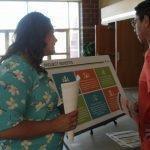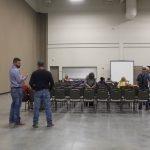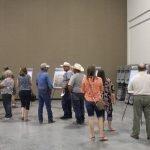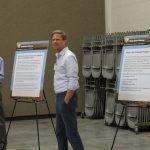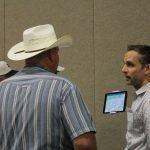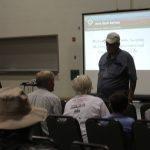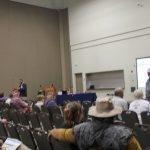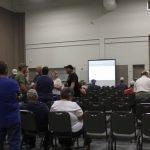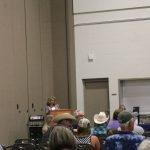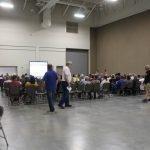The Carbon County Event Center played host to a crowd for the Uinta Basin Railway Project open house and presentation. Everyone in the community was welcome to join as the evening began at 5 p.m. with the open house. The event continued as a presentation was shown.
During the open house, attendees were invited to walk about the room and view the informational boards that were on display. The boards had worded plans and maps, along with other describing aspects, for attendees to read and ask questions about. If someone wanted to make a comment at the end of the presentation portion of the meeting, they were given a card to put their name on and asked to check a box saying they would have a comment. The meeting closed with these public comments from the audience.
This meeting was one of the first steps for the railway project. Josh Wayland, who is an environmental protection specialist on the Surface Transportation Board, presented the project to those in attendance. There were members from Carbon County in attendance but also many from the Uinta Basin.
“The Surface Transportation Board’s Office of Environmental Analysis (OEA) is preparing an Environmental Impact Statement (EIS) for a proposal by the Seven County Infrastructure Coalition to construct and operate an approximately 80 mile rail line to connect Uinta Basin to the interstate rail network,” the proposed projected stated.
There are three routes in consideration for the EIS. The Indian Canyon route would be about 80 miles and would connect to the existing rail line near Kyune, Utah. It would cross over land owned by the State of Utah, the U.S. Forest Service (USFS), the Bureau of Land Management (BLM) and the Ute Indian Tribe.
A route of approximately 105 miles is known as Wells Draw Route. This route would be connected to an existing Union Pacific (UP) railway near Kyune. There are two terminus points in the Uinta Basin close to South Myton Bench and Leland Bench. Crossed land for this route is managed by the BLM and the State of Utah and would not cross USFS or any tribal lands.
The third option is called the Craig Route, which would be approximately 185 miles of track. This rail line would connect to an existing UP rail line near Axial, Colo. The two terminus points in the Uinta Basin would be near South Myton Bench and Leland Bench. The Craig route would cross land owned by the BLM, the State of Utah and the State of Colorado; it would not pass through any USFS or tribal land.
The Seven County Infrastructure Coalition has recently stated that the Indian Canyon Route would be the preferred route.
Wayland mentioned during his introduction that this meeting was just the scoping part of the process. Scoping is meant to gather all public comments and concerns to create a common consensus that the majority can agree to work with. After the scoping is finished, they will move to drafting the Environmental Impact Statement (EIS). When this step has been accomplished, there will be a final EIS that will correspond with the draft made in the previous step. The final decision will be made after the Surface Transportation Board creates the final decision and cooperating agencies issue the record of the decisions to be made.
To open the oral comment section of the meeting, there were three standards set for each person who had requested to give a comment: it is not a debate, not a question and answer, and there was a three-minute cap. Each comment was recorded officially as well.
A few comments at the beginning of this section of the meeting were from people who are supportive the project; one being a county commissioner from Duchesne and another being Helper City Mayor Lenise Peterman. Peterman said that she is “happy to support.” There was also a comment made that the project “has potential,” giving feedback from both sides of the argument.
Although there were comments supporting the railroad, there were also remarks on the opposing side of the project. Many members of the Argile Wilderness Preservation Alliance gave their criticism against the railway project. Concerns added up to a list, while most revolved around money, property and land, safety, animals and others.
During this meeting, there was more commentary given against the project than there were comments supporting the project. All opinions made were civil and kept in line of the rules set before any comments were made.
Those that were unable to have their voice heard during this meeting may submit an electronic comment. The project website page is www.uintabasinrailwayeis.com or one can compose an email to uinta.eis@icf.com. They are very encouraging to comments and would like to hear concerns or opinions about the project.




